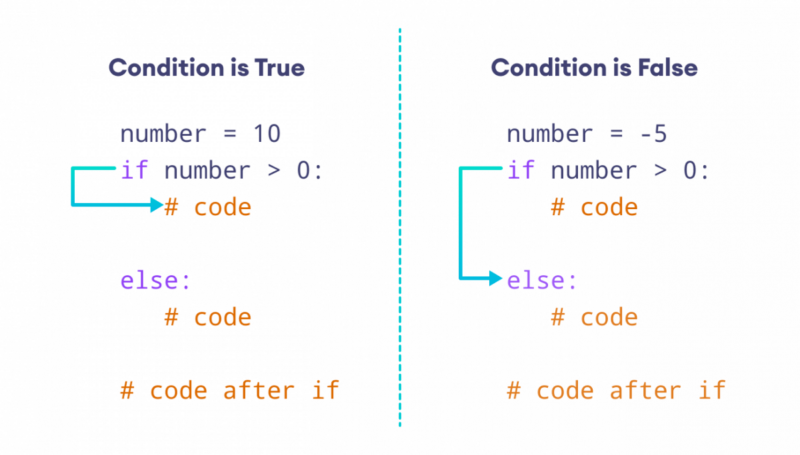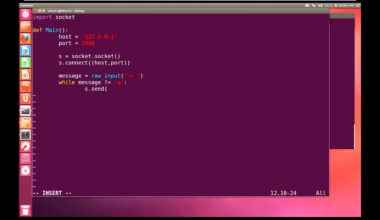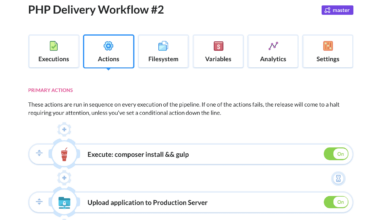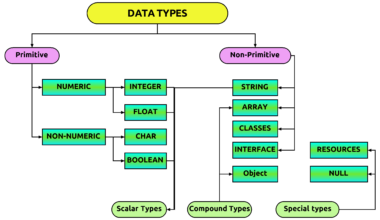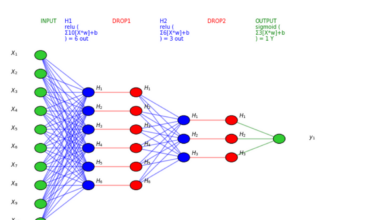Introduction to Python Conditionals
As a beginner in Python programming, one of the fundamental concepts you need to understand is conditionals. Conditionals help you create decision-making statements in your code. They allow your program to make decisions and execute different sets of instructions based on different conditions.
In Python, you can use conditional statements such as if, else, and elif to create decision-making statements. These statements allow you to check if a certain condition is met or not, and execute different blocks of code accordingly.
For instance, let’s say you want to create a program that checks if a certain number is even or odd. You can use the if-else statement to achieve this. Here’s an example:
num = 6
if num%2 == 0:
print("Even number")
else:
print("Odd number")
In this code, we first assign the value of 6 to the variable ‘num’. The if statement checks if the remainder of num divided by 2 is equal to 0. If it is, it prints “Even number”. If not, it prints “Odd number”.
Another useful conditional statement is the elif statement. This statement allows you to check multiple conditions and execute different blocks of code depending on which condition is met. Here’s an example:
age = 20
if age < 18:
print("You are a minor")
elif age >= 18 and age < 65:
print("You are an adult")
else:
print("You are a senior citizen")
In this code, we first assign the value of 20 to the variable ‘age’. The if statement checks if the age is less than 18. If it is, it prints “You are a minor”. If not, it moves on to the elif statement. The elif statement checks if the age is greater than or equal to 18 and less than 65. If it is, it prints “You are an adult”. If neither of the above conditions is met, the else statement is executed and it prints “You are a senior citizen”.
In conclusion, understanding conditionals is a crucial part of learning Python programming. It allows you to create decision-making statements in your code and execute different blocks of code based on different conditions. In the next section, we’ll dive deeper into the syntax and structure of if-else statements in Python.
Syntax and structure of If-Else statements
If-else statements are the most commonly used conditional statements in Python. They allow you to execute a block of code if a specific condition is met. If the condition is not met, the block of code following the else statement is executed.
The syntax of an if-else statement is as follows:
if condition:
# code to execute if condition is true
else:
# code to execute if condition is false
The if statement is followed by the condition that needs to be checked. If the condition is true, the code inside the if block is executed. If the condition is false, the code inside the else block is executed.
Let’s take an example of using if-else statement to check if a person is eligible to vote or not:
age = 18
if age >= 18:
print("You are eligible to vote")
else:
print("You are not eligible to vote yet")
In this code, we first assign the value of 18 to the variable ‘age’. The if statement checks if the age is greater than or equal to 18. If it is, it prints “You are eligible to vote”. If not, it executes the else block and prints “You are not eligible to vote yet”.
You can also use multiple if-else statements to check for various conditions. Here’s an example:
marks = 75
if marks >= 90:
print("Grade A")
elif marks >= 80:
print("Grade B")
elif marks >= 70:
print("Grade C")
elif marks >= 60:
print("Grade D")
else:
print("Grade F")
In this code, we have used multiple if-else statements to check the marks scored by a student and assign a grade accordingly.
It is important to note that the indentation of the code inside the if and else blocks is crucial in Python. Unlike other programming languages, Python uses indentation to indicate which code belongs to a specific block. Incorrect indentation can lead to syntax errors.
In conclusion, if-else statements are a crucial part of Python programming. They allow you to execute different blocks of code based on whether a specific condition is true or false. Make sure to pay attention to the syntax and indentation of your code when
Multiple Conditions and Nested If-Else Statements
In Python, you can use multiple conditions in if-else statements to create complex decision-making statements. You can also use nested if-else statements to check for multiple conditions within a single block of code.
To use multiple conditions, you can use the logical operators such as “and” and “or”. Here’s an example of using multiple conditions with the “and” operator:
age = 25
salary = 50000
if age >= 18 and salary >= 50000:
print("You are eligible for a loan")
else:
print("You are not eligible for a loan")
In this code, we first assign the value of 25 to the variable ‘age’ and 50000 to the variable ‘salary’. The if statement checks if the age is greater than or equal to 18 and the salary is greater than or equal to 50000. If both conditions are true, it prints “You are eligible for a loan”. If not, it executes the else block and prints “You are not eligible for a loan”.
To use nested if-else statements, you can place one if-else statement inside another if-else statement. Here’s an example:
num = 10
if num >= 0:
if num == 0:
print("Zero")
else:
print("Positive number")
else:
print("Negative number")
In this code, we first assign the value of 10 to the variable ‘num’. The first if statement checks if the num is greater than or equal to 0. If it is, it moves on to the nested if-else statement. The nested if-else statement checks if the num is equal to 0. If it is, it prints “Zero”. If not, it prints “Positive number”. If the num is not greater than or equal to 0, the else block is executed and it prints “Negative number”.
It is important to note that when using nested if-else statements, the indentation of the code inside each block is crucial. You need to make sure that the code inside the nested block is indented properly to indicate that it belongs to the outer block.
In conclusion, using multiple conditions and nested if-else statements can help you create complex decision-making statements in your Python code
Common Mistakes and How to Avoid Them
As a beginner in Python programming, it is common to make mistakes when using conditionals in your code. Here are some common mistakes and how to avoid them:
1. Syntax errors: Syntax errors occur when there is a mistake in the structure or format of your code. This can be caused by incorrect indentation, missing or misplaced brackets, or incorrect use of operators. To avoid syntax errors, make sure to double-check your code for any errors before running it.
2. Incorrect use of logical operators: Logical operators such as “and” and “or” are used to combine multiple conditions in if-else statements. One common mistake is to use the wrong operator. For instance, using “and” instead of “or” can lead to unexpected results. To avoid this, make sure to understand the difference between “and” and “or” operators and use them correctly.
3. Incorrect comparison operators: Comparison operators such as “==” and “>” are used to compare values in if-else statements. One common mistake is to use a single “=” instead of “==” which leads to an assignment instead of a comparison. To avoid this, make sure to use the correct comparison operator.
4. Not using elif statements: If you have multiple conditions to check, it can be tempting to use multiple if statements. However, this can lead to inefficient and hard-to-read code. Instead, use elif statements to check for multiple conditions in a single block of code.
5. Not testing your code: It is important to test your code thoroughly to make sure that it is working as expected. One common mistake is to assume that your code is correct without testing it. To avoid this, make sure to test your code with different input values and scenarios.
In conclusion, understanding and avoiding common mistakes when using conditionals in Python is crucial for writing efficient and error-free code. Make sure to double-check your code for syntax errors, use logical and comparison operators correctly, use elif statements for multiple conditions, and test your code thoroughly.
Importance of Mastering If-Else Statements in Python Programming
If-else statements are a fundamental concept in Python programming that allow you to create decision-making statements in your code. It is essential to master the use of if-else statements as it is an integral part of writing efficient and error-free code.
Here are some reasons why mastering if-else statements in Python programming is important:
1. Conditional statements are essential for decision-making: In any program, there are often situations where you need to make decisions based on certain conditions. If-else statements allow you to execute different blocks of code depending on whether a specific condition is true or false. This is crucial for creating programs that are both useful and efficient.
2. Increased efficiency: By using if-else statements, you can create programs that are more efficient. Instead of executing the same block of code for every input, you can create programs that execute different blocks of code based on different conditions. This can help reduce the number of unnecessary computations and make your program run faster.
3. Improved readability: If-else statements can help make your code more readable and easier to understand. By using conditional statements, you can create programs that are more organized and easier to follow. This can also make it easier for other programmers to understand and work with your code.
4. Flexibility: If-else statements allow you to create programs that are more flexible. You can create programs that can handle different types of input and scenarios, and execute different blocks of code based on different conditions. This can help make your program more versatile and useful.
5. Error handling: If-else statements can also be used for error handling in your program. By using if-else statements, you can create programs that can handle different types of errors and exceptions, and execute different blocks of code based on different error scenarios. This can help make your program more robust and reliable.
In conclusion, mastering if-else statements in Python programming is crucial for creating efficient, readable, and error-free code. By understanding the syntax and structure of if-else statements, you can create programs that are more flexible, efficient, and versatile. Make sure to practice using if-else statements in your programs to become proficient in using conditional statements.
